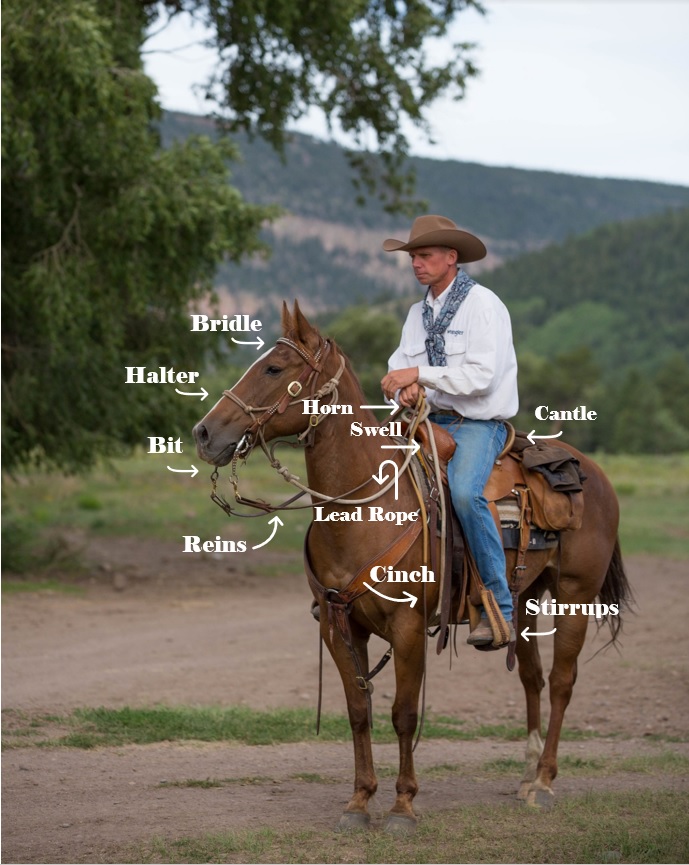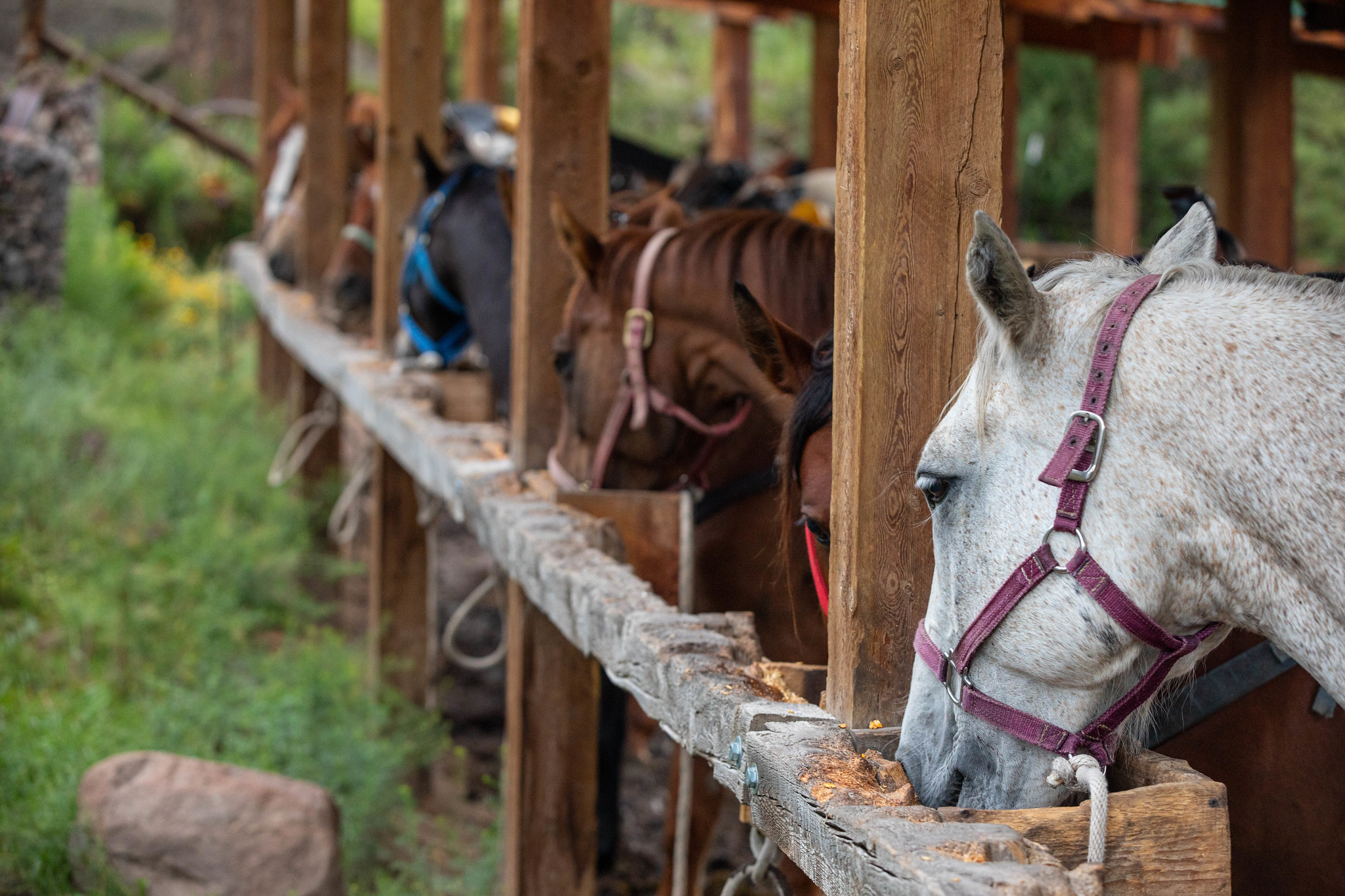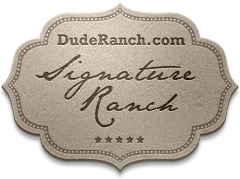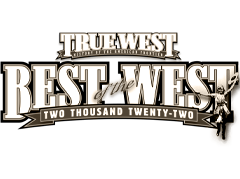Key Western Tack & Their Purpose
One of the things that we try to preach at the ranch is good horsemanship, knowledge, and skills around our equine friends. We hope that when guests leave the ranch, they know more than when they arrived, and should they (and we hope they do!) come back to us or ride anywhere else, the things they learned while they were with us come in handy. To know the basic parts of western tack and equipment is useful so that when David, Jane, or your wrangler refer to something to help you, you have context and understanding of the vocabulary.
Horn: The horn has a different purpose in a traditional sense, as it is a way to hold whatever cow or horse a cowboy has roped by wrapping the rope around the horn. However, for the trail riding that we do, it’s a wonderful way to help balance the rider. A rider can take a proper hold of the horn when they get too far behind or in front of the center of gravity, and help find the rhythm of the trot or the lope. There are also instances when a horse might decide to hop gently across a ditch, log, or small stream, and holding the horn can keep any cowboy in the saddle.
 Swell: The swell is the rounded rise that the horn sits on. Its sole purpose to the rider is to help keep the upper leg back in position. For the horse, the swell height and width is important for saddle fit for the horse’s shoulders.
Swell: The swell is the rounded rise that the horn sits on. Its sole purpose to the rider is to help keep the upper leg back in position. For the horse, the swell height and width is important for saddle fit for the horse’s shoulders.
Cantle: The cantle is the back of the seat of the saddle. The cantle is there to help catch the rider if they shift to the back of the saddle, but it is not there to actually hold the rider. It’s a common misconception that riders should push against the cantle. By looking at the picture, you can see that the cantle is above the horse’s lower back, just in front of the hips. If a rider sits on the cantle for too long, it can sore the horse quickly, and severely. This is why Jane preaches riding centered in the saddle!
Stirrups: The stirrups are what the rider places their feet into. Correct length for the stirrups is important not just for good balance, but to keep from getting sore in the knees. Too long, and the rider cannot reach them properly, and conversely, too short will result in joint aches. We never hesitate to keep adjusting them until they are as close to perfect as we can get them! We are also cognizant of the placement of the foot in the stirrup. Too much foot in the stirrup, and the ankle angle cannot flex properly, and too little foot can lead to a slip out. Ideal placement is the ball of the foot on the flat part of the stirrup, with the heels flexed down.
Cinch: The cinch is the belt-like piece of tack that goes under the horse’s belly; it is the most important part of the saddle in that it actually keeps the saddle on the horse. The wranglers work to make sure that it is snug enough to keep the rider safe without making the horse uncomfortable - saddle placement is also very important, not just depending on a tight cinch.
Bridle: The bridle is the leather piece of tack worn by the horse to hold the bit in their mouth. Each horse at the ranch has their own bridle that is fit to their specific head and needs.
Bit: The bit is the metal that goes through the horse’s mouth, held by the bridle. The bit sits across the horse’s tongue, and a natural gap in the teeth, assures that it doesn’t hurt them. There are a variety of bits, and each one is chosen for each horse depending on the need. When the rider pulls on the reins, the bit communicates to the horse what they would like them to do. It doesn’t always take a hard pull or yank to get the message across. Bits are actually very important, but the hands of the rider are actually more important. A harsh bit in soft hands can be ok, whereas even a gentle bit in hard hands can permanently damage a horse.
Reins: The reins are what connects the horse’s mouth to the rider’s hand. We tie knots in our guest horses’ reins, both to denote where to hold them sometimes, and also to keep the rider from dropping one. If the rider holds the reins with too much slack (too long), the horse cannot feel what the rider would like them to do. Should the reins be held too short, the horse only feels the pressure to stop, and might not move forward. As riders, we are always adjusting our rein length depending on what we are doing in the moment, albeit walking, trotting, loping, crossing water, etc.
 Halter: The halter is the colored nylon or rope bitless-bridle used to catch, lead and tie the horse. When we are trail riding, we leave the halters on underneath the bridle, so that we can tie up, lead or get hold of horses easily.
Halter: The halter is the colored nylon or rope bitless-bridle used to catch, lead and tie the horse. When we are trail riding, we leave the halters on underneath the bridle, so that we can tie up, lead or get hold of horses easily.
Lead rope: The lead rope is the rope that is attached to the halter, and is the most effective tool for leading the horse, and tying as needed. When we are out on the trail, we have the rope half-hitched to the saddle horn, but on breaks we ground-tie the horses and let them graze whilst dragging the rope. We undo the lead ropes at the river so that the horses reach the water to drink on afternoon rides - guests learn to half hitch them back, or the wranglers can take care of it.
Hopefully this explanation about some of the tack and equipment we use has been helpful! Knowing the jargon and vocabulary when you come ride with us will put you a little ahead when listening to Jane’s thorough horse orientation, and when wranglers are giving you tips and pointers out on the trail.
Come live the west with us!












